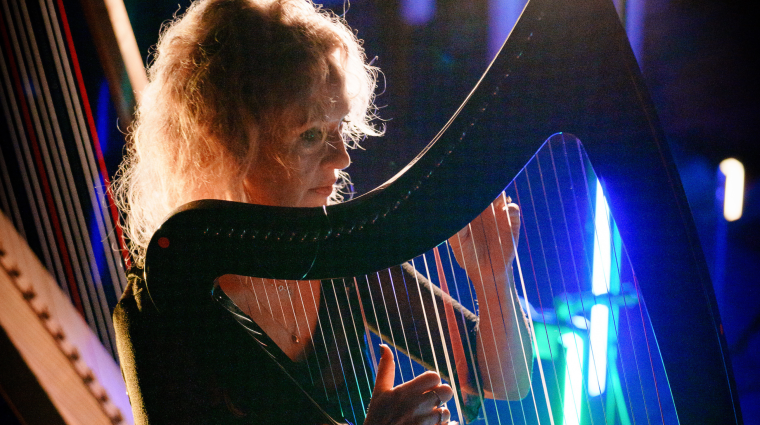
This year’s festival will feature the London premiere of Harpland, the acclaimed show by innovative harp and electronics duo FitkinWall. We caught up with one half of the duo, Ruth Wall, to learn more about the performance.
How did the idea for Harpland come about? What was the initial spark behind the project?
In a sense my Scottish background has driven this album. I come from the very far north of Scotland, an area called Sutherland which has a turbulent and hugely relevant history to what is going on in the world today. The enforced eviction and subsequent migration of farmers and crofters from the highlands over 200 years ago, as part of ‘the clearances’ which benefited wealthy Southern sheep farmers, provides the central focus. Composed by Graham, the music follows threads of migration into and out of Scotland. We chose ancient Highland tunes from the time of the Clearances, and Graham composed complete new works around them, interspersed with interviews from recent migrants into Scotland.
Each interview focused on a separate aspect of migration, Maria from Ukraine talked of the new life she has made with her son and mother in Sutherland miles away from her husband who is fighting in the Ukrainian war, ‘F’ from Iran of his journey to get to Scotland, Brigitte from Germany about her integration into the Highlands, Marija from Latvia about the unusual Russian-Ukrainian-Latvian culture within her own family and Lewis about his experience coming into Scotland from Newfoundland over 50 years ago.
Harp and electronics come from very different musical worlds. How did you approach blending these elements into a unified sound?
I perform on three wildly different harps while Graham manipulates sound from stage. Graham and I worked together a lot experimenting with various guitar pedals and effects, and in the end Graham decided that all the electronic effects would take as their starting point the sound of the harps. So there is a cohesion of sound world, even though we sometimes uses the electronics to create seemingly new.
Another aspect of the show that is key is the visual element, as we commissioned a choreographed light installation from artist Peter Freeman which works closely with the musical numbers. Graham and Peter worked together on this for a few months.
As a duo, how do you usually work together in the creative process? Where does an idea begin, and how does it evolve between you?
In this instance I was playing through some old songs and tunes from Scotland, while we were in lockdown in Cornwall. This was a very specific time, where our tours and performances were cancelled so we had time to play around. We were also talking a lot about migration, it was (and is) in the news most days so hard to ignore.
Graham would often come into my studio and either try new things out with me, or I would add in a pedal to see how various effects might work or at times he would run off with the music and come back with a brand new piece. In general Graham wanted to transform these old tunes, and has such a unique way of composing that I don’t interfere TOO much in his compositional process. Apart from the right to veto anything I didn’t like, or adding in new ideas here and there, or suggestions of new sounds or specific harp techniques or ornaments we can try out! There is a lot of back and forth as we both listen back to the work in progress and criticise all aspects of the works.
Later, after we had most of the music in place I interviewed several people who had moved into Scotland in the last 50 years. This took the project full circle, from music of past migrations and evictions to present day experiences. These stories were often deeply moving, and we had hours of recordings that Graham painstakingly edited. This was a really tricky job, as we were attached to the entire recordings, but we had to just take elements of each person’s voice – otherwise the show would last about 7 hours!
Rhythm and spatial awareness often play a strong role in your music. How did these elements manifest in Harpland?
There is a lot of space in Harpland, not only do we have room for the short interviews, but the music is more reflective than much of Graham’s work. He has very distinctive harmonic, structural and rhythmic fingerprints which you can hear in all his work, and certainly these do appear in Harpland, although most of the works are less frenetic than some of his other music. Spatial awareness is certainly heightened by Peter’s lighting installation, which works really well with the musical structures.
What kind of emotional or sensory experience do you hope audiences will have when they hear Harpland live?
We really don’t have strong expectations for how the audience will experience the show. However, we hope that we can present the music and interviews without too much agenda – letting them speak for themselves. If the audience come away a little bit changed or moved then that is a bonus!
Catch the full performance of Harpland on Tuesday 8 July at Wilton’s Music Hall as part of Spitalfields Music Festival 2025
